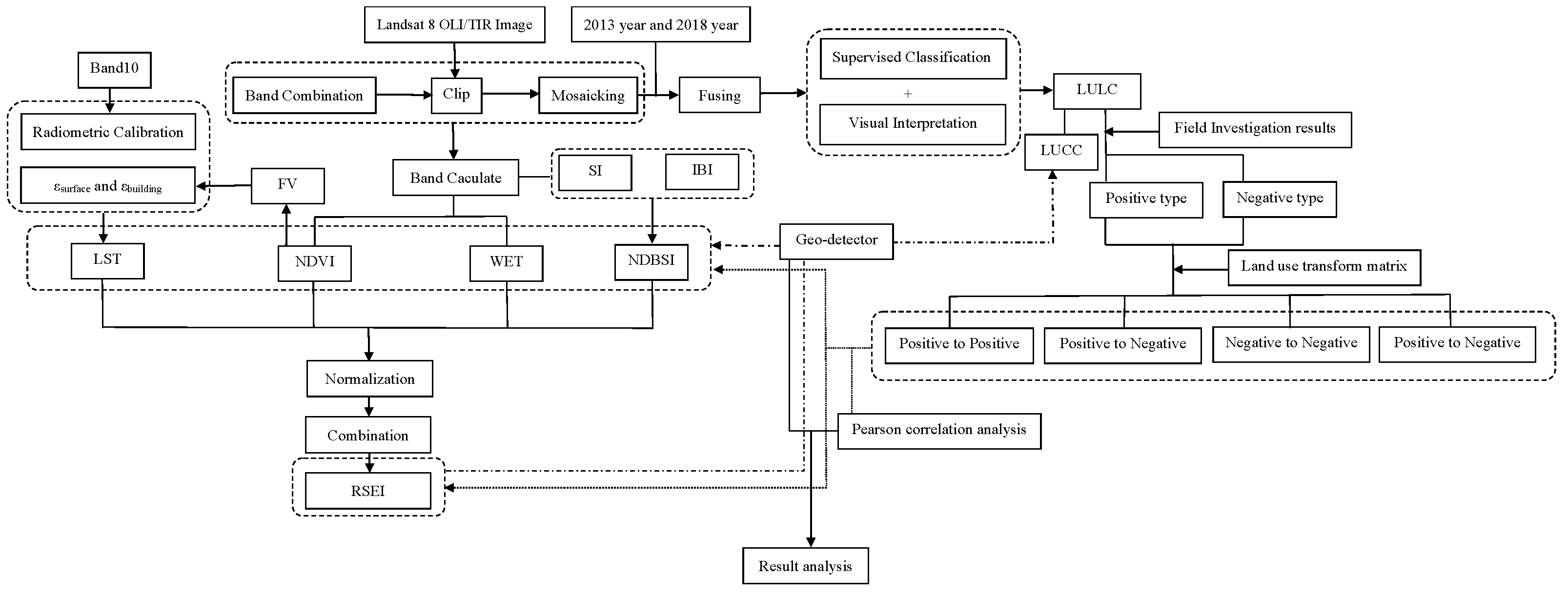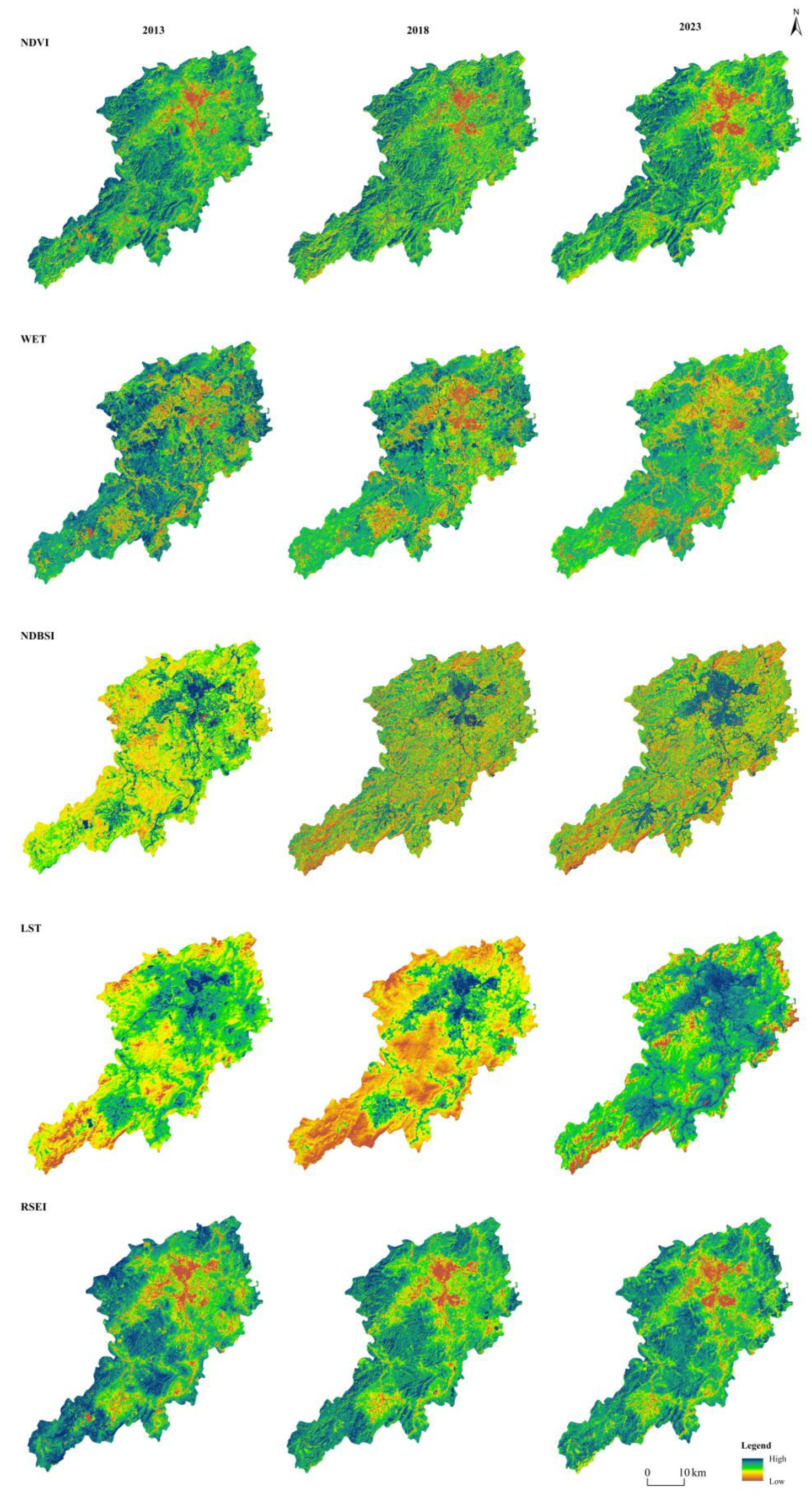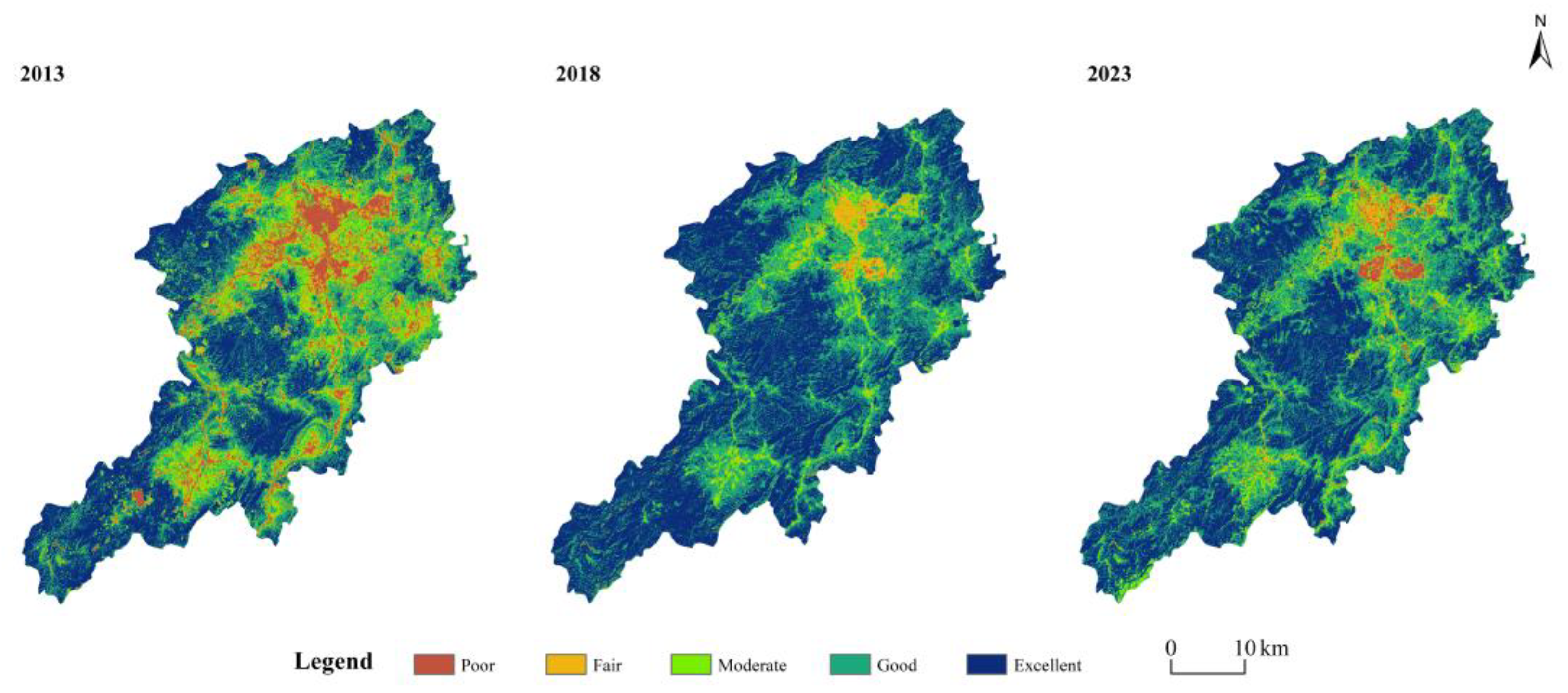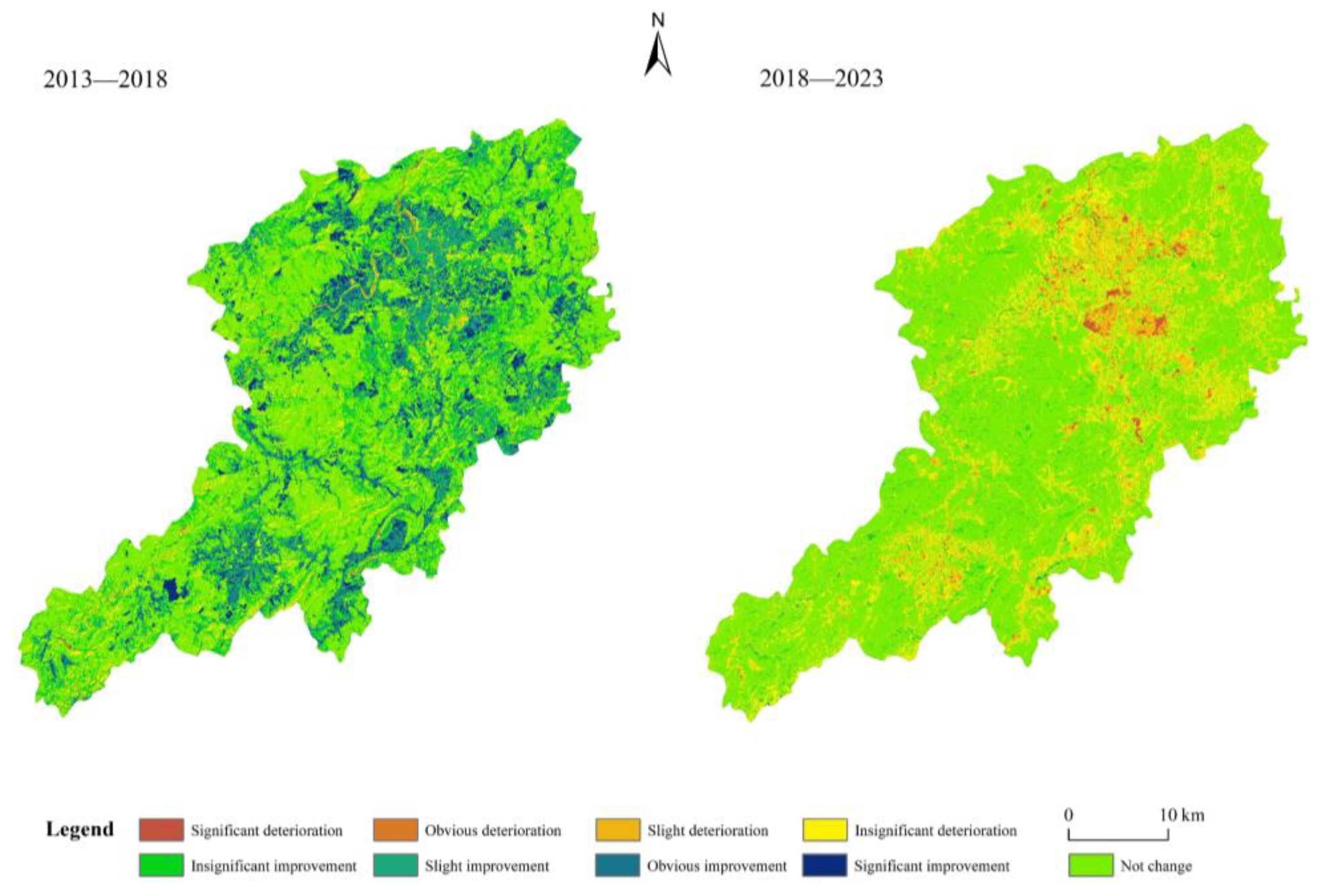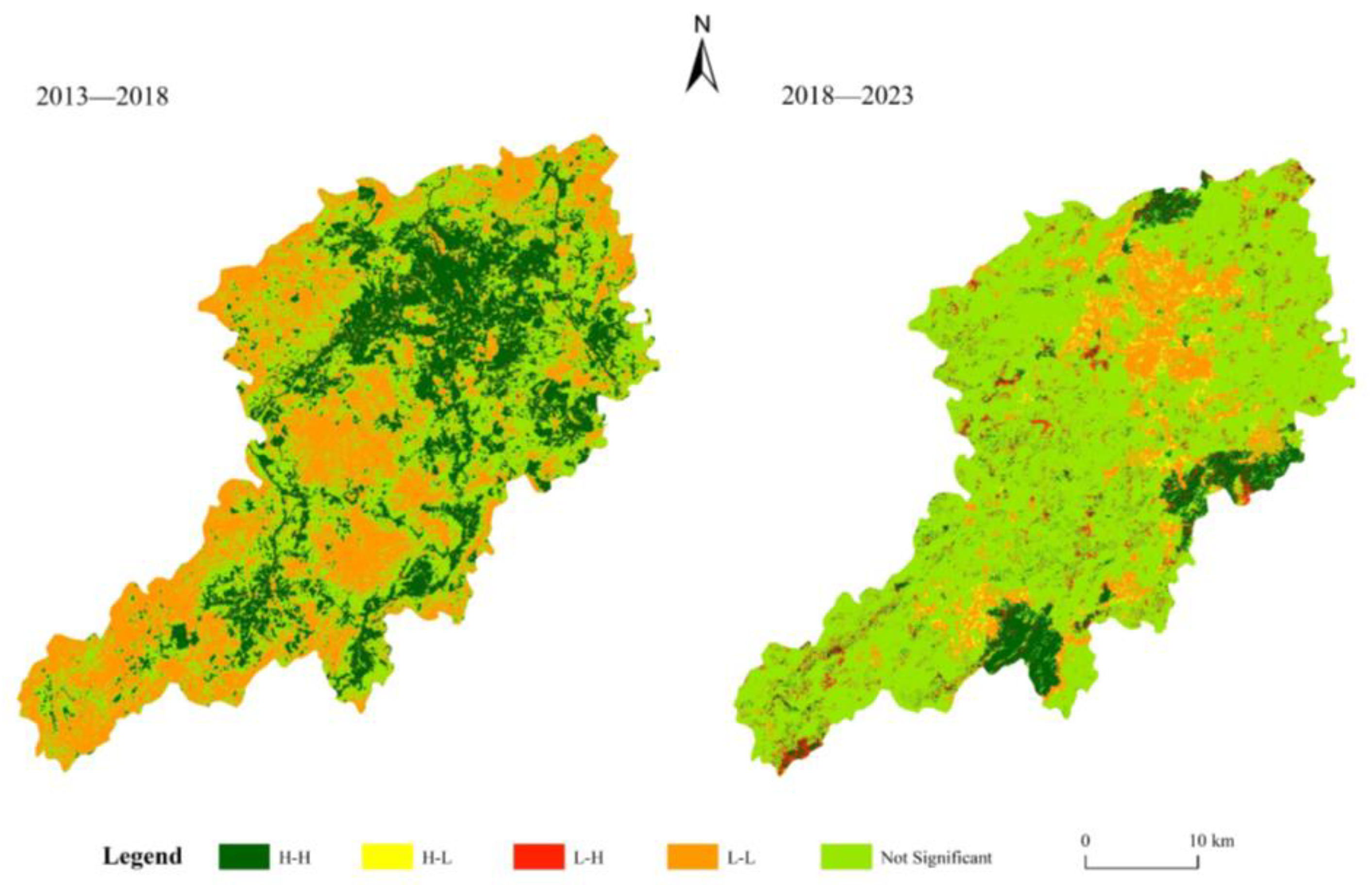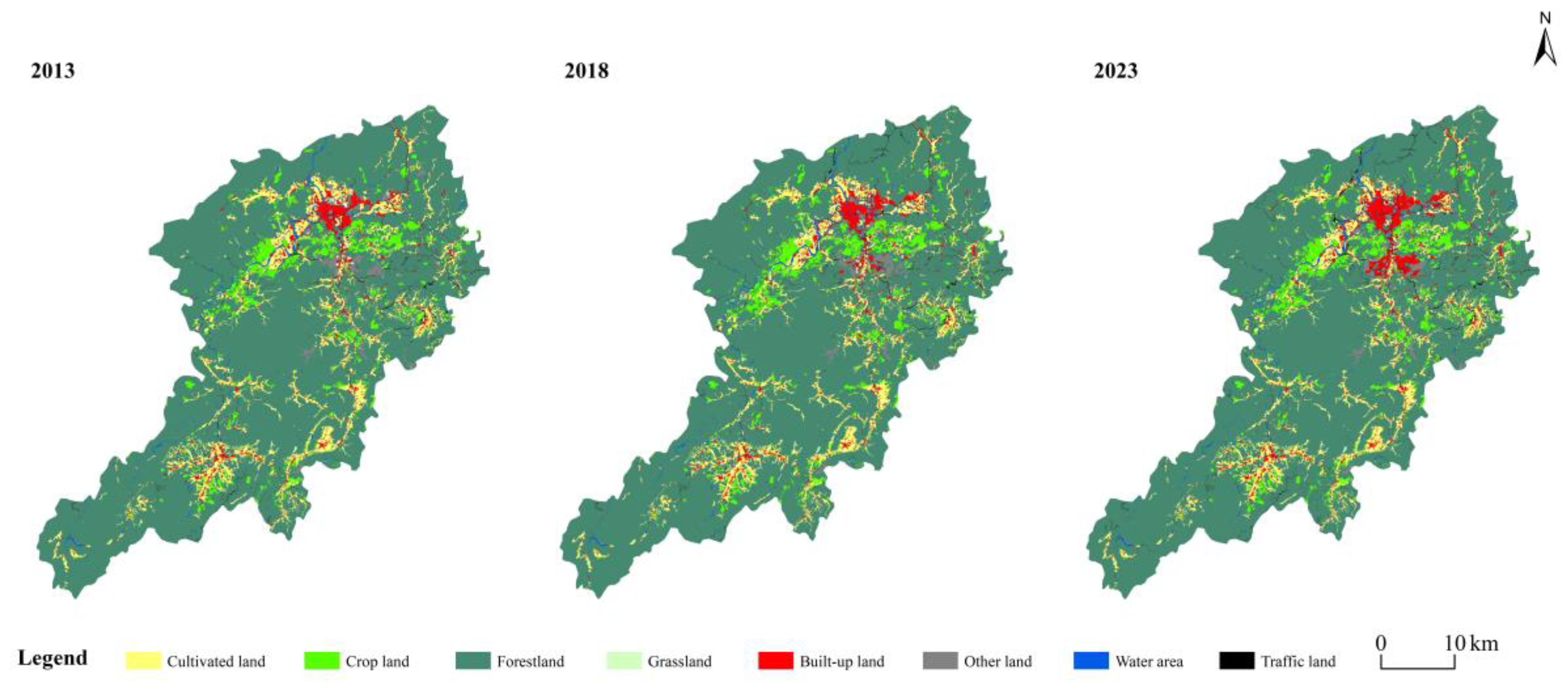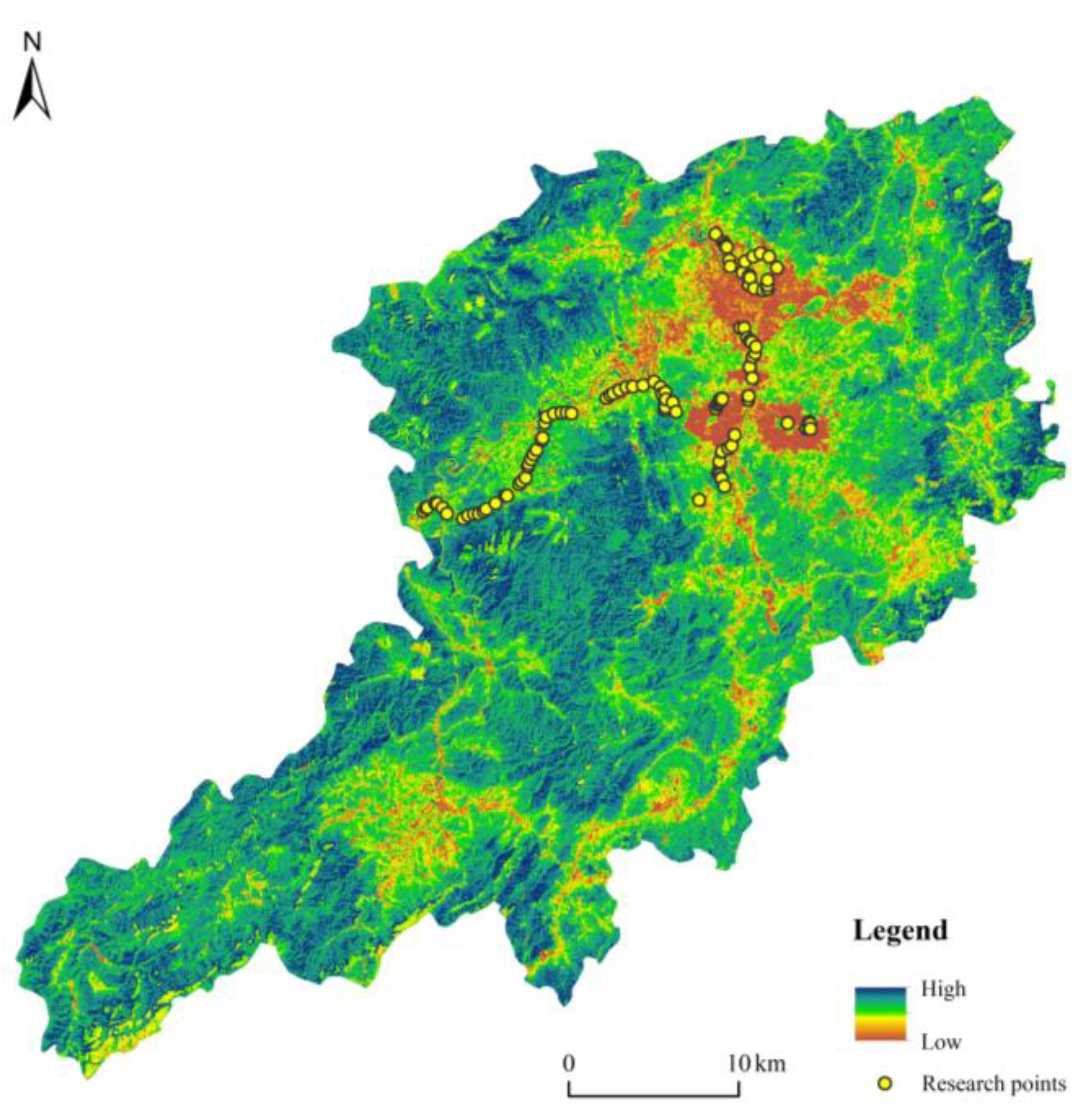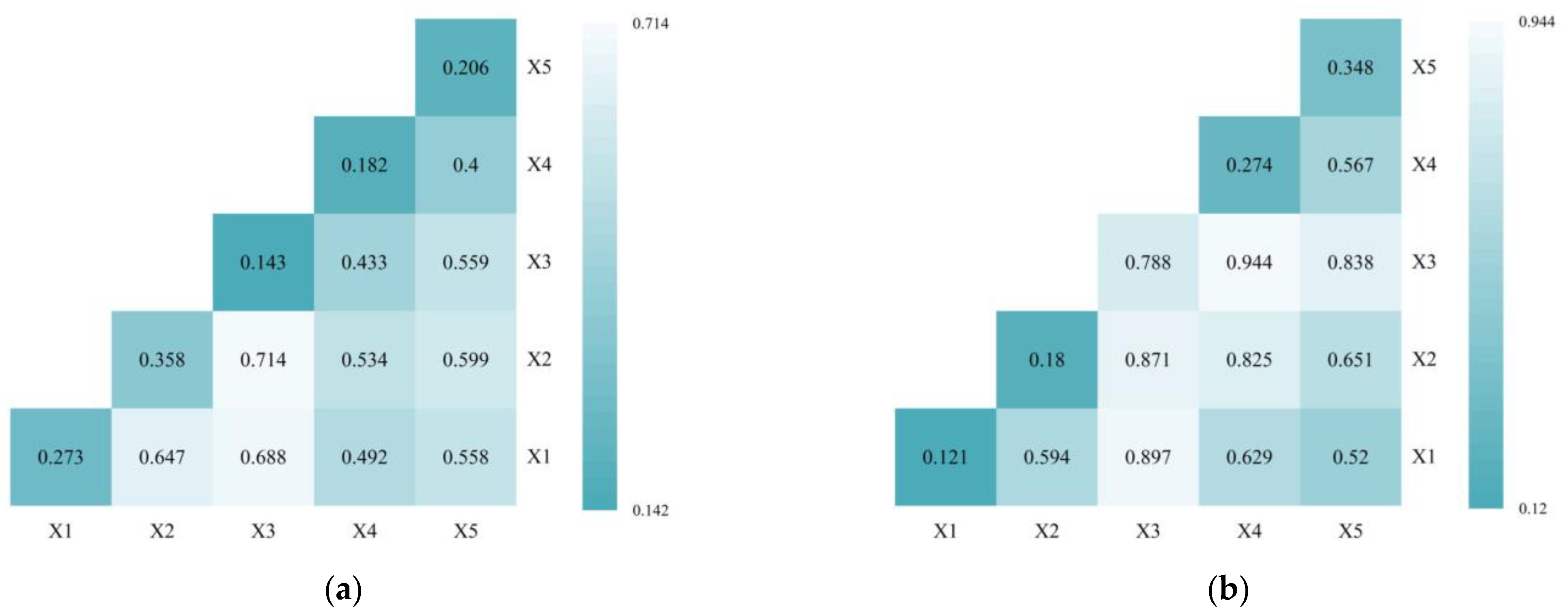1. Introduction
The impact of climate change and strong human activities on the ecological environment is enormous [
1,
2], China’s complex topography and climate system, which is greatly affected by climate change, coupled with a large population, the pressure on the ecosystem has subsequently increased, and the strengthening of ecological governance is an important measure to slow down the ecological pressure and improve the quality of the ecological environment. In order to promote the construction of an ecological civilization and the efficient and rational allocation of national land space, ecological restoration has been implemented in most areas of China, and the quality of the ecological environment has significantly improved [
3]. In this context, the influence of the ecological environment in the new urbanization, land space planning and other aspects gradually expand and account for the formation of constraints on it [
4,
5,
6,
7]. On the one hand, the development and utilization of national land space usually cause land use transfer [
8,
9], land types such as agricultural land and ecological land are squeezed, resulting in the gradual deterioration of ecological environmental quality [
10,
11]. On the other hand, the land transfer caused by the implementation of measures such as returning farmland to forests and lakes will improve the local vegetation cover and ecological environmental quality [
12,
13,
14]. The impacts of the two land use transfer processes on ecological environment changes show heterogeneity. Therefore, exploring the response mode of ecological environmental quality change to land use transfer can help the adjustment of local land use structure and improve regional ecological environmental quality. Relevant studies have proved that land use efficiency [
15,
16] and land cover change [
17] will have a direct impact on ecological efficiency and the ecological landscape, and urban expansion [
18] will have a negative impact on the ecological environment. And these effects tend to work in both directions, with ecological quality also reacting to socio-economic factors such as regional economy [
19], residents’ well-being [
20], and urban development [
21].
The most direct way to evaluate the regional ecological environmental quality is to calculate the ecological index. For example, ecological index (EI) [
22], remote sensing ecological index (RSEI) [
23], city ecological index (CEI) [
24] and other quantitative evaluation methods are used to calculate regional ecological environmental quality. Methods such as principal component analysis [
25], geo-detector model [
26], and improved remote sensing eco-index [
27] are also widely used to evaluate the ecological environmental quality. Yan et al. [
25] applied the PCA method to detect the factors influencing the ecological environmental quality of the urban agglomerations in the northern slopes of Tianshan Mountain, and the results showed that the degree of influence of land use/land cover (LULC) is high. Lai et al. [
26] applied the geo-detector model with the RSEI model to Pingtan Island, Songming County (China), and Yoshkar-Ola (Russia), to analyze and construct the ecological security pattern, and the results showed that drought is the biggest factor affecting the ecological environmental quality, and that it influences the ecological security pattern. Zhang Wei and other scholars [
27] introduced the salinity index (CSI) and water network density (WND) ecological environment evaluation model to evaluate the ecological environment of China’s arid zones, which showed that the improved ERSEI can fully characterize the surface details of arid zones. RSEI has been widely used in the study of changes in ecological environmental quality because of its objectivity [
28], and Zhang [
29], Yuan [
30], Zhang [
31], Yuan [
32] have used RSEI to analyze the changes of regional ecological environmental quality and its potential influencing factors, and the study shows that natural factors such as elevation, slope, vegetation cover, and average annual temperature, and anthropogenic factors such as land use and town construction have an impact on the ecological environment. Li [
33] and Xu [
34] used RSEI to evaluate urban ecological environmental quality, and the study shows that impermeable surfaces are not the most important factors for urban ecological environment quality. This study also showed that impervious surfaces have an impact on the quality of the urban ecological environment and the living environment.
Nanling Mountain is an important part of the hilly mountain belt in southern China, mainly developing subtropical evergreen broad-leaved forest and coniferous forest, with rich biodiversity. Artificial forests account for a high percentage of the area, with a single forest species and low forest quality, and urban construction and mining development have led to biodiversity damage and deterioration of ecological environmental quality. Longnan City is an important part of Jiangxi Province’s soil-preservation and water-source conservation area, with rich vegetation types, forming a distinctive comparison with the single plantation forest species in the Nanling Mountains. Previously, few studies have been conducted on the relationship between ecological quality and land use transfer in the Nanling Mountain area, especially in Longnan City. Therefore, exploring the response pattern of ecological environmental quality to land use transfer in Longnan City can help to map out the causes of ecological environment changes in Longnan City, with a view to providing reference for ecological protection and restoration in other counties of the Nanling Mountainous Region. However, most of the current studies explore the pattern of land use as a single factor on ecological environmental quality [
35,
36,
37], explaining the mechanism of action between the two at a qualitative level, and reporting the response pattern of ecological environmental quality to land use transfer in the study area; few scholars have conducted fieldwork in the study area, explored ecological environment indices of different land classes, and classified the land classes into directions.
In this study, the ecological environmental quality of Longnan City was evaluated by obtaining three remote sensing images of Longnan City in 2013, 2018 and 2023, and calculating the RSEI index. On this basis, combined with the results of fieldwork, the land use types were divided into two directions: positive land types that promote the ecological environment and negative land types that hinder the ecological environment. By calculating the Pearson’s correlation coefficient to explore the degree of correlation between the evolution of ecological environmental quality and land use transfer, and using a geo-detector to explore the spatio-temporal relationship between land use transfer and ecological environment evolution, the spatio-temporal response pattern of the ecological environmental quality of Lonan City to land use transfer was further explored. The research results provide an important perspective for understanding the relationship between ecological environment and land use, and also provide a scientific basis for mountain ecological protection and restoration.
3. Results
3.1. Temporal and Spatial Changes of Ecological Environmental Quality
3.1.1. Interannual Change of Ecological Environmental Quality
According to the ecological environmental quality classification standard issued by the National Environmental Protection Standard (HJ192-2015), the ecological environmental quality of Longnan City is divided into five levels, as shown in
Table 3.
According to the classification standard, the ecological environmental quality of Longnan City was classified and measured, and the results are shown in
Table 4. The mean values of the remote sensing ecological index of Longnan City in 2013, 2018 and 2023 were 0.789, 0.917 and 0.872, respectively, and the ecological environmental quality showed a trend of “first rising and then decreasing”.
The areas of poor ecological environment of Longnan City in 2013, 2018 and 2023 were 144.81 km2 (accounting for 8.759%), 6.815 km2 (0.414%) and 18.48 km2 (1.123%), respectively. The areas of fair ecological environmental quality were 73.1 km2 (4.441%), 31.223 km2 (1.897%) and 49.46 km2 (3.005%), respectively. The areas of the region with moderate ecological environmental quality were 221.634 km2 (13.464%), 79.431 km2 (4.825%) and 130.89 km2 (7.951%), respectively. The areas of the region with good ecological and environmental quality were 498.371 km2 (30.274%), 403.883 km2 (24.535%) and 570.077 km2 (34.63%), respectively. The areas with excellent ecological environmental quality were 708.894 km2 (43.063%), 1124.827 km2 (68.33%) and 877.273 km2 (53.291%), respectively.
In general, from 2013 to 2023, the poor ecological environment area, poor ecological environment area and general ecological environment area of Longnan City showed a downward trend. The area of good ecological environment and excellent ecological environment showed an increasing trend. The peak values of the area with poor ecological environmental quality and the area with excellent ecological environmental quality appeared in 2013 and 2018 respectively.
3.1.2. Temporal and Spatial Evolution of Ecological Environmental Quality
The spatial distribution of ecological and environmental quality in Longnan City from 2013 to 2023 is shown in
Figure 4. The ecological and environmental quality in the northern part of Longnan City is significantly lower than that in the southern part in the three periods. The area of poor ecological environmental quality is concentrated in the main urban area and its surrounding area. From 2013 to 2023, the scope of this area shows the characteristics of “inward contraction”. The regions with good ecological environmental quality are distributed in the southwest and central regions with wide forest cover, but the ecological environmental quality of the two regions increased first and then decreased due to the influence of human activities.
In order to explore the change of ecological environmental quality in Longnan City, this study processed the difference between the two periods of data before and after, and obtained the spatio-temporal differentiation of ecological environment change in the two periods (from 2013 to 2018 and from 2018 to 2023), as shown in
Figure 5. As can be seen from
Figure 4, the change of ecological environmental quality in Longnan City showed a strong spatial difference between the two periods. The change of ecological environmental quality in the north was significantly greater than that in the south, and the change was mainly distributed in the main urban area of Longnan City and its surrounding areas. From 2013 to 2018, the ecological environmental quality of Longnan City showed an overall trend of improvement, and there were two obvious improvement areas in the southern and northern regions respectively. From 2018 to 2023, the ecological environmental quality of Longnan City remained unchanged on the whole, but the ecological environmental quality of the northern main urban area showed obvious deterioration, which may be related to the expansion of the main urban area and the occupation of ecological land.
It is not difficult to see from the global Moran’s I index of Longnan City (
Table 5) and the local spatial autocorrelation LISA clustering diagram (
Figure 6) in the two time periods calculated by spatial autocorrelation: (1) The RSEI
i global Moran’s I index of Longnan City in the two periods were −0.13 and 0.28, and both passed the
p < 0.05 test. The results showed that the change pattern of ecological environmental quality in Longnan City showed negative spatial correlation from 2013 to 2018, and positive spatial correlation from 2018 to 2023. The global Moran’s I index increased significantly, indicating that from 2013 to 2023, the spatial agglomeration of ecological environmental quality in Longnan City increased significantly. (2) From 2013 to 2018, the changes of ecological environmental quality in Longnan City were mainly high-high clustering (ecological environmental quality improved) and low-low clustering (ecological environmental quality did not change significantly). The high-high cluster area is concentrated in and around the northern main urban area, and the low-low cluster area is distributed in most forest covered areas of Longnan City. (3) From 2018 to 2023, the changes of ecological environmental quality in Longnan City are mainly high-high clustering (ecological environmental quality becomes better), low-low clustering (ecological environmental quality becomes worse) and not significant (no significant changes). Low-low cluster areas are concentrated in and around the main urban area, while high-high cluster areas are distributed in a few areas in the north, east and south of Longnan City. The non-obvious area is almost all over the whole area of Longnan City, and the area is mostly forest-covered area.
3.2. Land Use Transfer Characteristics
According to the national land classification standard, the land use type of Longnan City is divided into eight types: cultivated land, garden land, forest land, grassland, construction land, traffic land, water body and other land (mainly man-made disturbance land). By counting the area of each category in each year (
Table 6) and calculating the land use transfer matrix for the two time periods (
Table 7 and
Table 8,
Figure 7), the following results were obtained.
The transfer of the above eight types of land use types in the 10 years from 2013 to 2023 is as follows:
- (1)
A total of 5.72 km2 of cultivated land was transferred in Longnan City, of which 4.64 km2 (mainly transferred to other land) was transferred from 2013 to 2018, and 3.11 km2 (mainly transferred to grassland) was transferred from 2013 to 2018; from 2018 to 2023, a total of 4.64 km2 was transferred out (mainly to other land), and a total of 0.45 km2 was transferred in (mainly to other land).
- (2)
A total of 5.64 km2 of garden land in Longnan City was transferred, of which 7.18 km2 (mainly transferred from forest land) and 0.96 km2 (mainly transferred to other land) from 2013 to 2018; From 2018 to 2023, a total of 0.6 km2 was transferred (mainly from other land) and a total of 1.19 km2 was transferred (mainly from other land).
- (3)
A total of 16.03 km2 of forest land was transferred out of Longnan City, of which 16.76 km2 (mainly transferred out of garden land and other land) and 5.32 km2 (mainly transferred into other land) from 2013 to 2018; from 2018 to 2023, a total of 6.7 km2 of forest land was transferred (mainly to other land), and a total of 2.12 km2 was transferred (mainly from cultivated land).
- (4)
A total of 1.49 km2 of grassland in Longnan City was transferred, of which 1.61 km2 (mainly transferred to other land) and 1.02 km2 (mainly transferred to building land and other land) from 2013 to 2018; from 2018 to 2023, grassland was transferred to 1.11 km2 (mainly transferred to other land) and 0.21 km2 (mainly transferred to other land).
- (5)
The building land of Longnan City increased by 13.25 km2, of which 7.09 km2 was transferred from 2013 to 2018 (mainly transferred from other land) and 4.56 km2 was transferred from 2018 to 2023 (mainly transferred from other land). A total of 11.07 km2 of building land was transferred (mainly from other land), and a total of 0.35 km2 was transferred (mainly from other land).
- (6)
The transportation land of Longnan City increased by 6.24 km2, of which from 2013 to 2018, the transportation land was transferred to 4.09 km2 (mainly transferred to forest land) and 2.25 km2 (mainly transferred to forest land); from 2018 to 2023, a total of 4.53 km2 of transportation land was transferred (mainly from forest land), and a total of 0.13 km2 was transferred (to other land).
- (7)
The water area of Longnan City has increased by 0.21 km2. From 2013 to 2018, the water area was transferred to 0.41 km2 (mainly transferred from other land) and 0.29 km2 (mainly transferred from cultivated land). From 2018 to 2023, the water area has been transferred to 0.22 km2 (mainly transferred from cultivated land). A total of 0.03 km2 is transferred out (transferred out to other land).
- (8)
Other land use in Longnan City decreased by 2.21 km2, of which 10.41 km2 was transferred from 2013 to 2018 (mainly transferred from construction land) to 13.25 km2 (mainly transferred from forest land). From 2018 to 2023, a total of 11.99 km2 of other land was transferred out (mainly for building land), and a total of 6.94 km2 was transferred into (mainly from forest land).
3.3. Temporal and Spatial Response of Ecological Environmental Quality Evolution to Land Use Transfer
3.3.1. Correlation between Ecological Environmental Quality Evolution and Land Use Type
In order to explore the correlation degree between ecological environmental quality and land use in Longnan City, this study conducted a field investigation of Longnan City, and selected 114 points containing eight typical land classes (
Figure 8) to calculate their ecological index. The results are shown in
Table 9.
In order to explore the spatio-temporal response mode of ecological environment evolution to land use transfer in Longnan City, based on
Table 9, the study divided five land types (forest land, garden land, water area and cultivated land) with good ecological environmental quality into positive factors, and three land types (construction land, transportation land and other land) with average and poor ecological environmental quality into negative factors. According to whether the land use type is a positive factor or a negative factor before and after the change, land use transfer is divided into four transfer modes: “positive–to–positive” (from positive factor to positive factor), “positive–to–negative” (from positive factor to negative factor), “negative–to–negative” (from negative factor to negative factor), and “negative–to–positive” (from negative factor to positive factor). On this basis, the temporal and spatial response model of ecological environmental quality to land use transfer in Longnan City was explored. Among the four indexes of NDVI, WET, NDBSI and LST, NDVI and WET have a positive impact on ecological environmental quality, while NDBSI and LST have a negative impact on ecological environmental quality [
28].
Based on this, on the basis of the land use transfer mode, this study determined the correlation coefficient between RSEI and NDVI, WET, NDBSI and LST by creating fishing nets (extracting 6586 sets of data points in the study area), and explored the response mode of ecological environmental quality to different land use transfer modes. The measurement results are shown in
Table 10.
On the whole, NDVI, WET and RSEI were positively correlated, while NDBSI and LST were negatively correlated. The correlation coefficient changes with the change of land transfer type, which is manifested in: (1) The correlation coefficients of positive indicators NDVI, WET and RSEI increased with the difference of land use transfer mode. In other words, the correlation coefficient is small when the land use transfer mode is “homotropic”, while the correlation coefficient is large when the land use transfer mode is “heterotropic”. This suggests that land classes characterizing positive indicators have a greater impact on ecosystem quality in areas of anisotropic change than in areas of isotropic change. (2) The correlation coefficients of negative indicators NDBSI, LST and RSEI change with the change of land use transfer results, that is, when the land use transfer results are positive, the correlation coefficient is small, and when the land use transfer results are negative, the correlation coefficient is large. This suggests that land classes characterizing negative indicators have a greater impact on the quality of the ecosystem when the transfer outcome is negative.
3.3.2. Temporal and Spatial Response Model of Ecological Environmental Quality Evolution to Land Use Transfer
In this study, the changes of ecological environmental quality under different land use transfer modes were divided into two periods, and the changes of ecological environmental quality were classified according to national standards, as shown in
Table 11. On this basis, the response of ecological environmental quality to the four land use transfer modes was further explored, and the statistical results are shown in
Figure 9 and
Table 12.
From 2013 to 2018: (1) The response of ecological environmental quality change to the “negative–negative” land use transform pattern is as follows: The area of obvious improvement (63.962%) of ecological environmental quality is relatively large, followed by the slight improvement area (27.905%), there are a small number of areas with insignificant deterioration (2.257%), insignificant improvement (3.908%) and slight deterioration (1.435%), there are very few areas with obvious deterioration (0.331%) and significant improvement (0.202%), and almost no significant deterioration (0.002%). (2) The response of the change of ecological environmental quality to the “negative–positive” land use transform pattern is as follows: the area of slight improvement (66.091%) ecological environmental quality is relatively large, followed by the area of insignificant improvement (22.449%), with a few areas of insignificant deterioration (5.696%), obvious improvement (1.782%), slight deterioration (2.892%) and obvious deterioration (1.029%), with a few areas of significant deterioration (0.061%) and no significant improvement. (3) The response of the change of ecological environmental quality to the “position–negative” land use transform pattern is as follows: the area of the ecological environmental quality is insignificant improvement (30.921%), and the area of the ecological environmental quality is slight improvement (17.625%), insignificant deterioration (14.588%), slight deterioration (13.284%) and significant deterioration (17.444%) is equal in proportion. There are a few areas of significant deterioration (6.079%), a few areas of obvious improvement (0.033%), and no areas of significant improvement. (4) The response of the change of ecological environmental quality to the “positive–positive” land use transform pattern is as follows: The area of the ecological environmental quality is slight improvement (37.442%), followed by the area of insignificant improvement (27.129%), and then the area of obvious improvement (11.883%) and insignificant deterioration (17.1%). There are a few areas of slight deterioration (5.535%), a few areas of significant improvement (0.219%) and obvious deterioration (0.219%), and almost no significant deterioration (0.024%).
From 2018 to 2023: (1) The response of the change of ecological environmental quality to the “negative–negative” land use transform pattern is as follows: The proportion of areas with slight deterioration (26.202%), insignificant deterioration (33.268%) and slight improvement (22.001%) ecological environmental quality is the same, followed by the obvious deterioration (12.073%) area, there are a few slight improvement (5.636%) areas, there are a few significant deterioration (0.517%) and obvious improvement (0.304%) areas, and there are no significant improvement areas. (2) The response of the change of ecological environmental quality to the “negative–positive” land use transform pattern is as follows: The area of obvious deterioration (29.097%) of ecological environmental quality is relatively large, followed by the slight deterioration (22.714%) area, the area of insignificant deterioration (15.303%), insignificant improvement (13.554%) and slight improvement (14.799%) is the same, there are a few obvious improvement (4.505%) areas, almost no significant deterioration (0.028%) area, no significant improvement area. (3) The response of the change of ecological environmental quality to the “positive–negative” land use transform pattern is as follows: the area with obvious deterioration (50.101%) of ecological environmental quality accounts for a large proportion, the area with insignificant deterioration (16.612%) and the area with slight deterioration (20.746%) accounts for the same proportion, there are a few areas with slight improvement (8.791%) and significant deterioration (2.509%), a few areas with obvious improvement (0.219%) and no significant improvement. (4) The response of the change of ecological environmental quality to the “positive–positive” land use transform pattern is as follows: The area of the ecological environmental quality is not significant deterioration (49.69%), followed by the area of insignificant improvement (28.514%), and the area of slight deterioration (14.809%) again, there are a small number of slight improvement (4.79%) and obvious deterioration (1.821%) areas, there are very few significant improvement (0.318%) areas, and almost no obvious improvement (0.318%) and significant deterioration (0.043%) areas.
3.4. Analysis of Temporal and Spatial Evolution Factors of Ecological Environmental Quality in Longnan City
The geographical detector was used to analyze the driving factors for the spatial heterogeneity of the evolution of ecological environmental quality in Longnan City. The inter-annual changes of NDVI, WET, NDBSI, LST and LUCC (reflected by a single dynamic attitude of land use) were taken as X
1, X
2, X
3, X
4 and X
5, and the inter-annual changes of RSEI were taken as Y for detection. As shown in
Table 13 and
Figure 10.
From 2013 to 2018, the q-values of X1, X2, X3, X4 and X5 were 0.27, 0.36, 0.14, 0.18 and 0.21 respectively, indicating that changes in WET have the greatest impact on changes in ecological quality, followed by NDVI; LUCC ranked third in terms of its influence; LST had less influence; and the NDBSI had virtually no impact. From 2018 to 2023, the q-values of the indicators were 0.12, 0.18, 0.79, 0.27 and 0.35, indicating that changes in NDBSI had the greatest impact on changes in ecological quality, followed by LUCC; LST had the third highest impact; WET had a low impact; and NDVI had virtually no impact.
The results of interaction detection are both double factor enhancement or nonlinear enhancement, indicating that the impact of interaction between factors on ecological environmental quality in Longnan City is stronger than that of any single factor. From 2013 to 2018, the two combinations of X4 with X2 and X5 were the main factors influencing the changes in ecological environmental quality in Longnan City, which means that the intensity of changes in ecological environmental quality under the influence of the interaction of LST with WET and the interaction of LST with LUCC is greater than the intensity of changes in the three factors when they act alone. From 2018 to 2023, the four combinations of X3 with X1, X2, X4, X5 and the combination of X4 and X5 were the main factors causing changes in ecological environmental quality in Longnan City. That is, the intensity of changes in ecological environmental quality under the influence of the interaction of NDBSI and NDVI, NDBSI and WET, NDBSI and LST, NDBSI and LUCC and LST and LUCC is greater than the intensity of changes when these five factors act alone.
5. Conclusions
Based on RSEI index, geo-detector, the field observation and LUCC mapping by remote sensing, this paper evaluated the ecological environmental quality of Longnan City in 2013, 2018 and 2023, divided land use types into two directions (positive and negative), studied the correlation degree and the spatio-temporal relationship between the ecological environmental quality evolution and land use transfer, and further explored the spatio-temporal response pattern among them. The RSEI of Longnan City in 2013, 2018 and 2023 were 0.789, 0.917 and 0.872, respectively. There were large spatial differences in the ecological quality of Longnan City, and that of the northern part was significantly worse than that of the southern part, with the northern main urban area gradually deteriorating in the trend of “inward contraction”. From 2013 to 2023, Longnan City was dominated by the transfer out of forest land (16.03 km2 transferred out) and the transfer in of construction land (13.25 km2 transferred in).
The correlation coefficients between the NDVI, WET, NDBSI, LST and the RSEI under the positive–positive transform pattern were respectively 0.523, 0.408, −0.268, −0.241; 0.767, 0.337, −0.479, −0.528 in positive–negative transform pattern; 0.741, 0.521, −0.121, −0.472 in negative–positive transform pattern; 0.561, 0.5, −0.523, −0.511 in positive–positive transform pattern. When the land category is transferred in the same direction, the correlation between positive indicators NDVI, WET and RSEI is higher than that of heterogeneous transfer. While the land use type is transferred to the negative land category, the correlation between the negative indicators NDBSI, LST and RSEI is higher than that of the transfer to the positive land category. The method proposed in this study for characterizing the positive and negative impacts on the ecological environmental quality of the land classes is accurate.
The spatial and temporal responses of ecological environmental quality to different land use transform patterns are highly correlated with the changes in ecological environmental quality. From 2013 to 2018, the area with better ecological environmental quality was always larger than that with worse ecological environmental quality under different land use transform patterns. From 2018 to 2023, the area with worse ecological environmental quality was always larger than that with better ecological environmental quality under different land use transform patterns. LUCC always had a strong impact on the ecological environmental quality in Longnan City in both periods. Specifically, from 2013 to 2018, the interaction between LUCC and LST (q = 0.4) had a greater impact on the ecological environmental quality change than the interaction between other factors in this period; from 2018 to 2023, the interaction between LUCC and both NDBSI and LST (LST ∩ LUCC = 0.567, NDBSI ∩ LUCC = 0.838) also had a greater strength of influence on changes in ecological quality during this period than the interactions among other factors. The interaction between LUCC and other indicators has a greater effect on the evolution of ecological environmental quality in Longnan City than the single factor effect.

